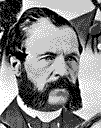

 |
 |
|
All efforts for woman suffrage were abated during the Civil War, its advocates giving themselves wholeheartedly to the cause of freedom as exemplified by the abolition of slavery. But when the war was over, its objects achieved, it seemed desperately hard to these devoted, high-minded women that uneducated colored men, just released from slavery, should be adjudged worthy of the ballot which was still withheld from the educated and patriotic white women who had helped to save the nation and free the slaves. They were astounded to have the discriminatory word "male," which had never before been used in the federal constitution, appear in the fourteenth amendment, and made vigorous effort to prevent it. Their failure in this effort, due partly to the influence of those who had been their friends and supporters, and who now joined in the rallying cry--"This is the negro's hour"--made them realize as never before the force and weight of the opposition. The Civil War, however, had developed courage and self-reliance in women. Many of them had managed the farm, the shop, the office, as well as the family, while the man of the house was away at the war. Women had achieved notable results in the organization and management of the Sanitary Commission and other relief agencies. So added ability and determination were enlisted in the suffrage cause after the war. |
||
 A. M. Thomson |
The first state convention for universal suffrage was held at Janesville, October 9 and 10, 1867.9 When called to order, it was designated the "Impartial Suffrage Convention." The moving spirits were the Honorable John T. Dow, member of the state assembly; Joseph Baker of Janesville ; Mrs. L. R. Stewart of Brodhead ; Mrs. J. H. Stillman of Whitewater ; Mrs. F. Harris Reid of Beaver Dam ; and Mrs. Jennie L. Hildebrand of Fond du Lac. Letters were read from Lucy Stone and Susan B. Anthony, and steps were taken to form a permanent state organization.10 An executive committee was appointed for this purpose. A committee on finance was also chosen. The Janesville Daily Gazette gave extended notices of this convention, with the purpose of which the editor, A. M. Thomson, declared himself in sympathy. "All that is necessary," he wrote, "to carry forward this great measure to a successful issue, is for the women themselves to take hold vigorously and determinedly of the good work."11 |
|
 Lucius Fairchild |
Coincident with this organization, and fostered by the same leaders, was a determined effort to secure a constitutional amendment for this reform. John T. Dow, assemblyman for Rock County, introduced into the legislature of 1867 a joint resolution for such an amendment. This resolution passed both the senate and the house, and was approved by Governor Fairchild, April 11, 1867.12 In the assembly the supporters of the measure secured a vote of sixty-three in favor to twenty-two opposed. However, it was required by the constitution, then as now, that an amendment should pass two legislatures before being submitted to the people. The real struggle was therefore postponed until 1868; and it was to create public sentiment therefor that the Janesville convention of 1867 was held. |
 Mrs. Lucius (Frances Bull) Fairchild |
| The legislature of 1868 received several well-signed petitions asking for the ratification of this proposed amendment. The bill was introduced in the assembly by President William C. Whitford of Milton College. Mr. Dow, who was no longer a member, organized a lobby for the measure. Notwithstanding these strong friends, the general apathy on the subject was so marked that the resolution was rejected in the assembly by a vote of thirty-six to forty-six.13 | ||
9The Wisconsin Historical Library possesses a copy of the Proceedings of this convention as well as of the addresses of the Reverend S. Farrington of Janesville and the Reverend Sumner Ellis of Milwaukee, delivered before the convention.
10 It is interesting to note that "resolutions were forwarded to the convention by a meeting of citizens of the village of Menomonee," probably Menomonee Falls, in Waukesha County.
11 Janesville Daily Gazette, Oct. 10, 1867.
12 Assembly Journal, 1887; Laws of Wisconsin, 1867, 200.
13 Assembly Journal, 1868; Janesville Gazette, Feb. 1 and March 5. 1868.